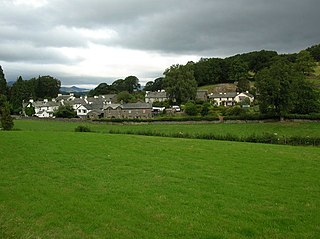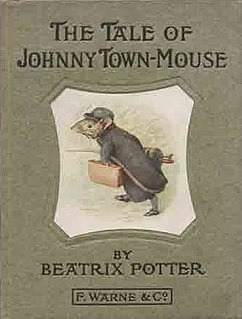
Helen Beatrix Potter was an English writer, illustrator, natural scientist, and conservationist. She is best known for her children's books featuring animals, such as The Tale of Peter Rabbit.
Roly poly or Roly Poly may refer to:

Hill Top is a 17th-century house in Near Sawrey near Hawkshead, in the English county of Cumbria. It is an example of Lakeland vernacular architecture with random stone walls and slate roof. The house was once the home of children's author and illustrator Beatrix Potter who left it to the National Trust. It is a Grade II* listed building. It is open to the public as a writer's house museum, shown as Beatrix Potter herself would have known it.

The Tale of Samuel Whiskers or The Roly-Poly Pudding is a children's book written and illustrated by Beatrix Potter and first published by Frederick Warne & Co. in October 1908 as The Roly-Poly Pudding. In 1926, it was re-published as The Tale of Samuel Whiskers. The book is dedicated to the author's fancy rat "Sammy" and tells of Tom Kitten's escape from two rats who plan to make him into a pudding. The tale was adapted to animation in 1993.

Jam roly-poly, shirt-sleeve pudding, dead man's arm or dead man's leg is a traditional British pudding probably first created in the early 19th century. It is a flat-rolled suet pudding, which is then spread with jam and rolled up, similar to a Swiss roll, then steamed or baked. In days past, Jam Roly-Poly was also known as shirt-sleeve pudding, because it was often steamed and served in an old shirt-sleeve, leading to the nicknames of dead-man's arm and dead man's leg. In the past it was known as roly poly pudding.

The Tale of Mrs. Tittlemouse is a children's book written and illustrated by Beatrix Potter, and published by Frederick Warne & Co. in 1910. The tale is about housekeeping and insect pests in the home, and reflects Potter's own sense of tidiness and her abhorrence of insect infestations. The character of Mrs. Thomasina Tittlemouse debuted in 1909 in a small but crucial role in The Tale of The Flopsy Bunnies, and Potter decided to give her a tale of her own the following year. Her meticulous illustrations of the insects may have been drawn for their own sake, or to provoke horror and disgust in her juvenile readers. 25,000 copies of the tale were initially released in July 1910 and another 15,000 between November 1910 and November 1911 in Potter's typical small book format.

The Tale of Ginger and Pickles is a children's book written and illustrated by Beatrix Potter, and first published by Frederick Warne & Co. in 1909. The book tells of two shopkeepers who extend unlimited credit to their customers and, as a result, are forced to go out of business. It was originally published in a large format which permitted Potter the opportunity to lavish great detail on the illustrations and also allowed her to include black-and-white vignettes. Potter filled the tale with characters from her previous books. The book was eventually republished in the standard small format of the Peter Rabbit series and was adapted to drama in 1931.

The Tale of Jemima Puddle-Duck is a children's book written and illustrated by Beatrix Potter. It was first published by Frederick Warne & Co. in July 1908. Potter composed the book at Hill Top, a working farm in the Lake District she bought in 1905. Following the purchase, her works began to focus on country and village life, incorporating large casts of animal characters and sinister villains. Jemima Puddle-Duck was the first of her books set wholly at the farm with background illustrations based on the farm buildings and yard, and nearby locales.

The Tale of Tom Kitten is a children's book, written and illustrated by Beatrix Potter. It was released by Frederick Warne & Co. in September 1907. The tale is about manners and how children react to them. Tabitha Twitchit, a cat, invites friends for tea. She washes and dresses her three kittens for the party, but within moments the kittens have soiled and lost their clothes while scampering about the garden. Tabitha is "affronted". She sends the kittens to bed, and tells her friends the kittens have the measles. Once the tea party is underway however, its "dignity and repose" are disturbed by the kittens romping overhead and leaving a bedroom in disorder.

The Tale of Mr. Tod is a children's book written and illustrated by Beatrix Potter, first published by Frederick Warne & Co. in 1912. The tale is about a badger called Tommy Brock and his arch enemy Mr. Tod, a fox. Brock kidnaps the children of Benjamin Bunny and his wife Flopsy, intending to eat them, and hides them in an oven in the home of Mr. Tod. Benjamin and his cousin Peter Rabbit have followed Tommy Brock in an attempt to rescue the babies. When Mr. Tod finds Brock asleep in his bed, he determines to get him out of the house. His initial attempt fails, and the two eventually come to blows. Under cover of the fight, the rabbits rescue the baby rabbits. The tale was influenced by the Uncle Remus stories, and was set in the fields of Potter's Castle Farm. Black and white illustrations outnumber those in colour. The tale is critically considered one of Potter's "most complex and successful in plot and tone."

The Tale of the Pie and the Patty-Pan is a children's book written and illustrated by Beatrix Potter, and published by Frederick Warne & Co. in October 1905. It tells of a cat called Ribby and a tea party she holds for a dog called Duchess. Complications arise when Duchess tries to replace Ribby's mouse pie with her own veal and ham pie, and then believes she has swallowed a small tin pastry form called a patty-pan. Its themes are etiquette and social relations in a small town.

Near Sawrey and Far Sawrey are two neighbouring villages in the Furness area of Cumbria, England. They are located in the Lake District between the village of Hawkshead and the lake of Windermere. The two lie on the B5285, which runs from Hawkshead to the west bank of the Windermere Ferry, a car ferry across Windermere 1 mile to the east of the villages.

The Tale of Johnny Town-Mouse is a children's book written and illustrated by Beatrix Potter and first published by Frederick Warne & Co. In December 1918. The tale is based on the Aesop fable, "The Town Mouse and the Country Mouse", with details taken from Horace's Satires 2.6.79-117. It tells of a country mouse and a city mouse who visit each other in their respective homes. After sampling the other's way of life, both express a decided preference for their own. The book was critically well received. The Johnny Town-mouse character appeared in a 1971 ballet film, and the tale has been adapted to a BBC television animated series.

The World of Peter Rabbit and Friends is a British animated anthology television series based on the works of Beatrix Potter, featuring Peter Rabbit and other anthropomorphic animal characters created by Potter. 14 of Potter's stories were adapted into 9 films, and the series was originally shown in the U.K. on the BBC between 20 December 1992 and 25 December 1998. It was subsequently broadcast in the U.S. on Family Channel between 23 October 1992 and 23 October 1995.

The Story of Miss Moppet is a tale about teasing, featuring a kitten and a mouse, that was written and illustrated by Beatrix Potter, and published by Frederick Warne & Co for the 1906 Christmas season. Potter was born in London in 1866, and between 1902 and 1905 published a series of small-format children's books with Warne. In 1906, she experimented with an atypical panorama design for Miss Moppet, which booksellers disliked; the story was reprinted in 1916 in small book format.

The Story of A Fierce Bad Rabbit is a children’s book written and illustrated by Beatrix Potter, and first published by Frederick Warne & Co. in December 1906. The book tells of a bad little rabbit who forcefully takes another rabbit's carrot, but soon loses his tail and whiskers after being fired upon by a hunter. The book was intended for babies and very young children, and was originally published on a strip of paper that folded into a wallet and was tied with a ribbon. The format was unpopular with booksellers, and eventually reprinted in the standard small book format of the Peter Rabbit library. Although the book sold well, there are not many left in existence. It provides the young child with an introduction to books and the Peter Rabbit universe.

Appley Dapply's Nursery Rhymes is a collection of nursery rhymes written and illustrated by Beatrix Potter, and published by Frederick Warne & Co. in October 1917. Potter had a lifelong fascination with rhymes, and proposed a book of short verses called Appley Dapply to Warne following the release of The Tale of Peter Rabbit in 1902. Warne preferred Potter's original fantasies to her derivative work, and gave Appley Dapply little encouragement. The book was set aside in favour of other projects.
Frederick Warne & Co. is a British publisher founded in 1865. It is famous for children's books, particularly those of Beatrix Potter, and for its Observer's Books, which have gained a cult following.

Moss Eccles Tarn is a tarn on Claife Heights, near Near Sawrey in the Lake District, Cumbria. It is currently owned by the National Trust and known as an attractive tarn for fishing and walking. It is known for its association with Beatrix Potter – she owned the tarn and donated it to the National Trust after her death, and it served as inspiration for some of her stories.
A mitten is a glove without individual finger openings.

















